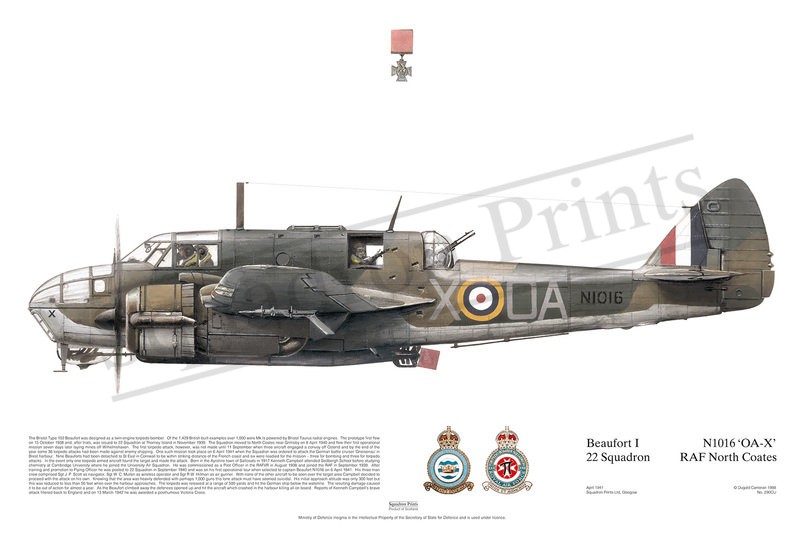#290CU Beaufort I, 22 Sqn print

Description
Squadron Prints Lithograph No. 290CU - N1016 'OA-X', Beaufort I, 22 Squadron, RAF North Coates.
The Bristol Type 152 Beaufort was designed as a twin-engine torpedo bomber. Of the 1,429 British built examples over 1,000 were Mk.Is powered by Bristol Taurus radial engines. The prototype first flew on 15 October 1938 and, after trials, was issued to 22 Squadron at Thorney Island in November 1939. The Squadron moved to North Coates near Grimsby on 8 April 1940 and flew their first operational mission seven days later laying mines off Wilhelmshaven. The first torpedo attack, however, was not made until 11 September when three aircraft engaged a convoy off Ostend and by the end of the year some 36 torpedo attacks had been made against enemy shipping. One such mission took place on 6 April 1941 when the Squadron was ordered to attack the German battle cruiser ‘Gneisenau’ in Brest harbour. Nine Beauforts had been detached to St Eval in Cornwall to be within striking distance of the French coast and six were readied for the mission – three for bombing and three for torpedo attacks. In the event only one torpedo armed aircraft found the target and made the attack. Born in the Ayrshire town of Saltcoats in 1917 Kenneth Campbell attended Sedbergh School before studying chemistry at Cambridge University where he joined the University Air Squadron. He was commissioned as a Pilot Officer in the RAFVR in August 1938 and joined the RAF in September 1939. After training and promotion to Flying Officer he was posted to 22 Squadron in September 1940 and was on his first operational tour when selected to captain Beaufort N1016 on 6 April 1941. His three man crew comprised Sgt J cott as navigator, Sgt W ullen as wireless operator and Sgt R W illman as air gunner. With none of the other aircraft to be seen over the target area Campbell decided to proceed with the attack on his own. Knowing that the area was heavily defended with perhaps 1,000 guns this lone attack must have seemed suicidal. His initial approach altitude was only 300 feet but this was reduced to less than 50 feet when over the harbour approaches. The torpedo was released at a range of 500 yards and hit the German ship below the waterline. The resulting damage caused it to be out of action for almost a year. As the Beaufort climbed away the defences opened up and hit the aircraft which crashed in the harbour killing all on board. Reports of Kenneth Campbell’s brave attack filtered back to England and on 13 March 1942 he was awarded a posthumous Victoria Cross.
You may also like
-
SIGNED King's Birthday Flypast 2024, Memorial Formation
ZJ913; ZK374; ZK38129 Sqn; BBMFRAF Coningsby -
333 FS F-15E Strike Eagle print
87-0199333 FS, 4 FWSeymour-Johnson AFB, North Carolina
